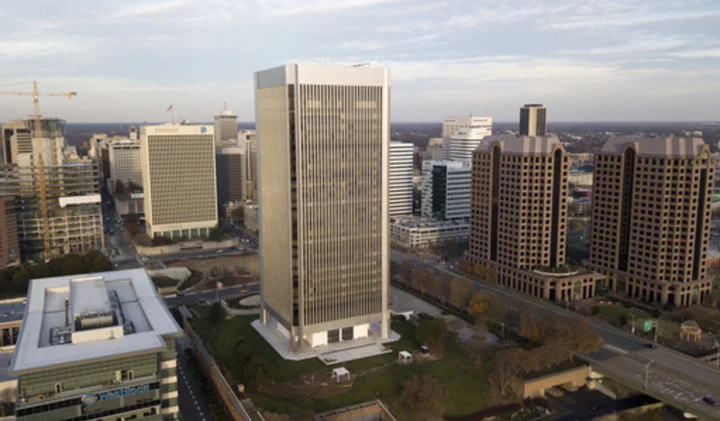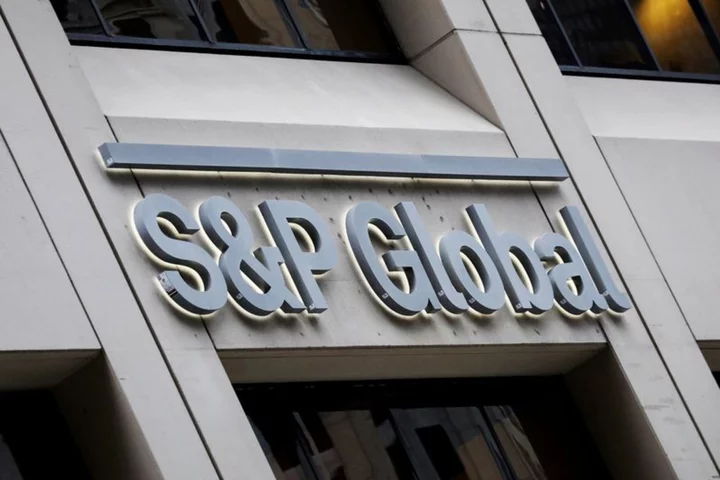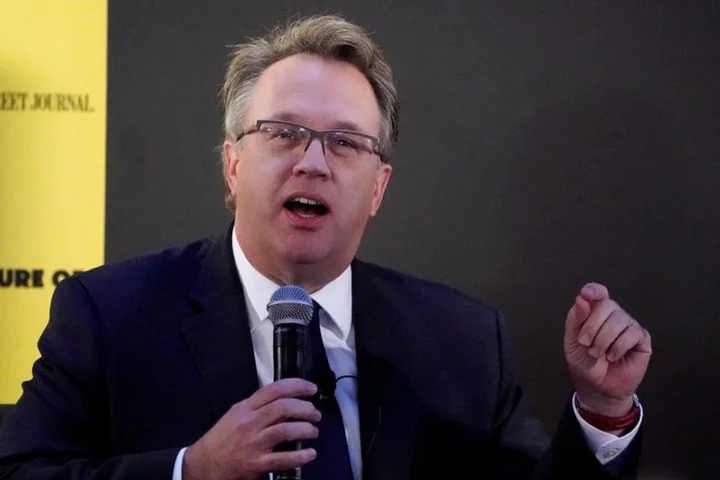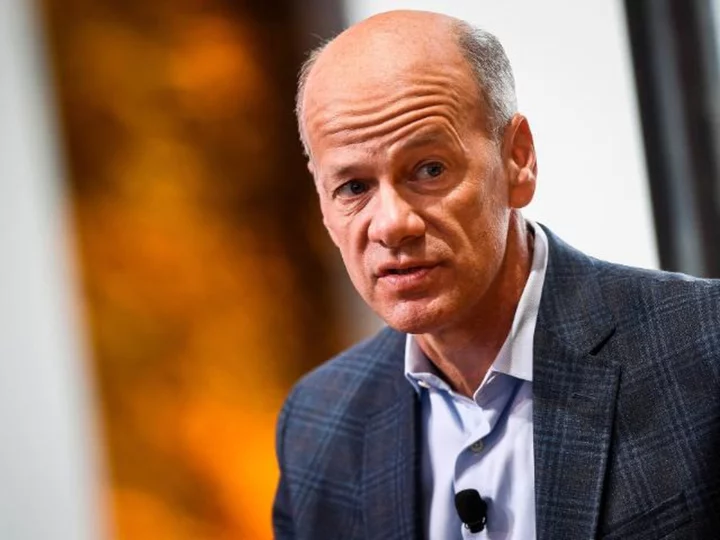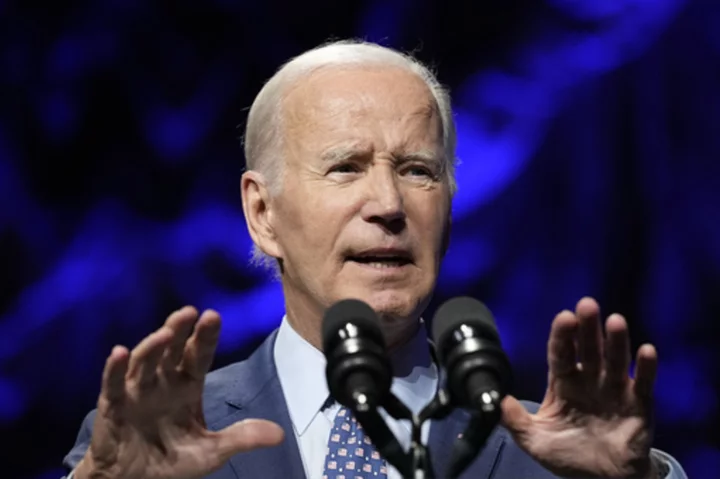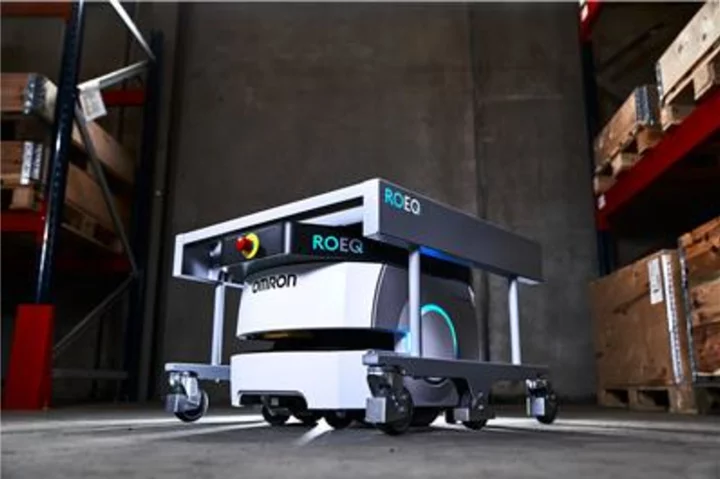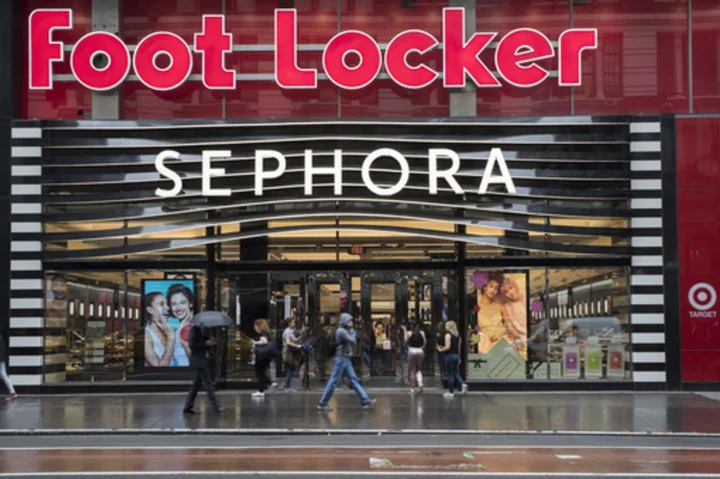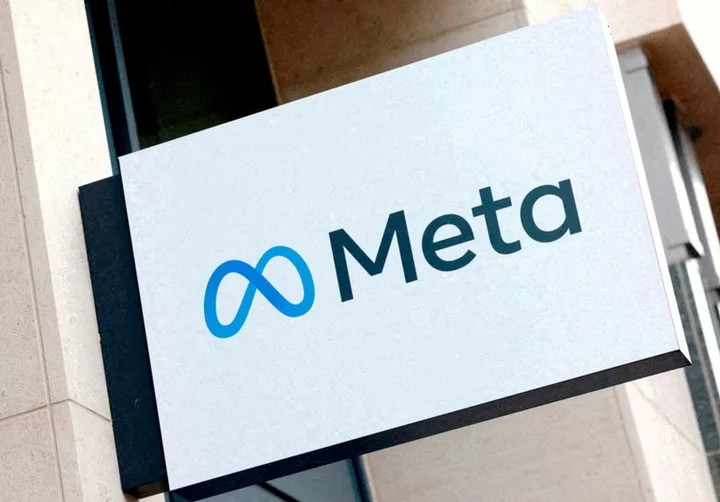WASHINGTON (AP) — Here is a transcript of an Associated Press interview Wednesday with Tom Barkin, president of the Federal Reserve Bank of Richmond. It has been lightly edited for length and clarity.
Q: Certainly the news of the day is the inflation report. What did you think of that? What did it tell us about where inflation is going and how the Fed's policies are working?
A: Well, it’s — inflation remains, I’d call it stubbornly high. The headline and the core were about as expected, but if you just look through any one report, and you focus on the core, which is probably the best place to look, month after month after month, it’s coming in at .4%, .5%, or .3%, where you’d really like it to be moving down and in concert with our target.
You do need to look through the one timers. There are some numbers that moved up a lot like used cars, there’s the numbers that moved down a lot like air travel and hotels. But I think just looking through all that it still paints a picture of inflation that is stubbornly high.
And what I think is going on, I’ve spoken a little about this, is businesses, firms, consumers had 30 years of inflation that was basically non-existent, very stable and at our target, and that really tightened their expectations around 2% as what’s reasonable both to ask for and to receive. And I think the experience the last two years, where inflation has been high, persistent, and talk about inflation, has been ubiquitous, that’s just opened people’s apertures. I think firms are pushing to see if they can’t get more price. Consumers seemed more willing to accept it. And therefore I think getting back to our target is just going to take time. It’ll just take time.
Q: What does that mean, though, for the Fed statement at the last meeting, which said — at least suggested that there may be a pause. Is that something you supported and how does today’s report affect that?
A: The way I thought about the last meeting is that looking forward, you can see a lot of uncertainty. That uncertainty includes the impact of our moves to date, on demand, on inflation. It includes the impact of credit conditions on the behavior of banks and the implications for demand and inflation. It includes how fast consumer spending is going to erode as some of the fiscal and excess savings wear out. And it includes outside events — things like the debt ceiling, and so a lot of uncertainty and a lot of data coming.
Just the timing of the round means we’re going to get between meetings, two CPIs, two job reports, in addition to all the normal monthly spending things. So it made me comfortable with data dependence, so that’s what I think the message of the last statement is in my mind, is that — it’s explicitly not — explicitly not a pause or even necessarily a peak, it gives you the optionality to do more, if you need to do it. And also the optionality to wait if waiting is appropriate. So there’s a lot of data coming in. There’s a lot of uncertainty and I think it gives me and us the time to take all that in.
Q: Right. Not only did we get the inflation report today, we had the jobs report last week, which was fairly healthy. I mean, those two combined, would they make you comfortable pausing at the next meeting or not?
A: Well, my read on the jobs report is you can find signs of it cooling, whether that be the rate of job growth slowing or the drop in the openings or the stabilization of the quits, but it’s still very hot. And a 3.4% unemployment (rate), as you know, is a 54-year low, wage growth still elevated. We saw the productivity numbers this week. And so unit labor costs still elevated.
And I think what’s going on is part of it is that employers who had to scramble to get workers during the pandemic are now reluctant to shed, and there’s still a lot of segments that are tight. Frontline entry level jobs, waiters and waitresses, still very — still very tight. Construction, skilled trades, still very tight. So I think you still got a market that’s hot. As I said, we’re going to get a lot of data over the next five weeks between now and the meeting. And so we’ll see what we learn from that. And I’m certainly not somebody who likes to front-run the data in terms of declaring a point of view for the next meeting.
Q: But I think last month, you said that you wanted to see more evidence that inflation is moving back to the Fed’s target. So, just to revisit today’s report, did the numbers today, suggest that inflation is going back to the target or not so much?
A: I’m not convinced yet. I’m open to being convinced and the way I think about it is this. We’ve told ourselves lots of — not we the Fed — people in the market have told one another many stories over the last year and a half about how inflation would settle.
There was a view for a while it would be supply chain and commodity prices, coming back to normal, and they have largely come back to normal, but you still have inflation. There was a story that with the Fed on the case and rates moving as rapidly as they did, expectations would come down and that would bring inflation down and market measures of expectations have come down. But inflation is still stubbornly high as I said.
There’s some today who say the metrics are lagging and in fact, inflation’s already down, even though the numbers haven’t yet shown it, and I’m still looking for evidence of that. But I think the core story now is the demand story. And what it says is, the combination of waning fiscal, eroding consumer balance sheets, or the lag effect of rate moves and credit tightening coming in the banking system, is going to bring demand down and consequently inflation. And I think that’s a plausible story.
And the signals would start with demand and head to inflation. And so I’m going to be looking for signals that demand is in fact coming down to levels that are consistent with disinflation, and of course, that — would love that to be confirmed by signals that inflation is coming down as well.
We’re seeing at this point consumer spending, the last two months seems to have settled and the real time spending metrics I monitor seem to suggest that continuing. Housing of course has settled, business investment (has declined). But the job market as we talked about earlier, still seems relatively hot. I’m still open to the notion that demand is settling and inflation will follow in relatively short order, but I’m really quite attuned — I wouldn’t say I’m convinced yet. I’m open to the possibility. I’m looking for evidence and the reports coming over the next period of time.
Q: Well, how big a factor do you expect the tightening of credit to be in the aftermath of the bank turmoil and what might you be hearing from, say businesses in your district, and banks in the district about how this is all playing out?
A: So I’m in touch with the banks in my district, I’m hearing them say deposit flows are stable, they’ve invested in liquidity. And I’m pretty encouraged by the resilience I’m seeing in these banks. But as you know, even resilient banks will tighten credit if they need to preserve liquidity or you know, optimize margins. And I definitely feel like I’m hearing about tightening credit in segments like commercial real estate. And I’d also say for marginal credits. I also feel that banks, whatever their marginal credit is, whether it’s a less attractive credit from — a loss profitability standpoint or less attractive from a profitability standpoint — that they’re on the margin, tightening.
So I do think it’s happening. I think the challenge is figuring out what kind of impact that has on the broader economy. There have been a number of studies but honestly, the studies are swamped by the ’08 and the Lehman Brothers episode. And of course, if you took signal from that, you would suggest this would be a big impact. But you know, there just haven’t been very many similar situations to take much signal out of so I’ve not seen any evidence at this point that this is that kind of incident. So I’m trying to figure out what the impact is going to be. We don’t really have precursors that feel directly relevant.
Q: With that in mind, what is your forecast for the economy and where we go from here?
A: As I think I said earlier, I definitely see demand cooling. Most compelling to me is consumer spending, which you know, is 68% of the economy. And, after a very robust January, February, March, and then some numbers I’m seeing for April, feel like it has gone from significant growth to plus or minus flattish, year over year.
And so, that’s the — that cooling. Business investment has also come down, at least in real terms. And so, you put those together, that’s a big part of the economy. So I definitely see an economy that’s cooling. And I do think the open question out there is, is it cooling enough to tame inflation the way that we need to, and that that’s hard to — it’s hard to know at this point.
I think the big uncertainty and that is obviously — we don’t just have rate increases dictating this. We have credit conditions, which we talked about earlier, are hard to quantify. And we have uncertainty in the broader environment. If you pick up the paper right now, all you read about are the meetings that were held in Washington yesterday, and so I think that amount of uncertainty, I believe will cool the economy — the combination of those things, will cool the economy more, but that’s why I’m watching and seeing if I’m right.
Q. But the Fed staff is forecasting a recession, is that further than you’re willing to go at this point?
A: It’s easy for me to imagine a slowdown that turns to negative GDP growth, this year or next year. But we’ll have to see. It’s also conceivable that it wouldn’t and so I think that’s the challenge you get when you go out two or three or four quarters, is a lot of these outside events are going to dictate it more than, if you will, the model-based estimates of what lagged rate moves due to GDP and spending.
But like I said I am seeing it cool. And it makes sense to me it would cool, given what we’ve done, given credit conditions. And given the spending of the excess savings that’s been supporting so much of the economy.
Q. Right. What would it take — how high is the bar for raising rates, again, whether in June or later this year? What kind of data would you need to see to support another rate hike?
A. To me, what I’m testing is the story that I took you through, which is, is demand slowing at a fast enough pace to bring inflation down, in a compelling way back toward our 2% target. I think that’s the statement — as I said, you can tell a plausible story that gets there but you have to be open both to that being right and that being not right.
So I’m going to be looking hard for signals of whether that is right or not right. I think your direct question was, what did it take to restart? I don’t feel any particular — well, we haven’t stopped. I don’t think any particular — I don’t think there’s any particular hurdle in my mind to doing it other than being convinced.
And so what would be the things that would be most compelling to me? Signals that demand, in fact, was not ebbing. So if you started seeing strong demand, whether that be consumer spending or job growth, that started moving, not in this gradual cooling pattern, but something that was more significant, because then that would challenge the story on the demand side. Another version of that would be something that made you think inflation was accelerating or poised to accelerate. And that could be (inflation reports), it could also be supply side kind of issues, on the inflation side. So again, there’s a story you’re testing in your mind. And if you see evidence that supports it, great, if you see evidence that goes the other way, you’ve got to be attuned to that.
Q: Is the Fed's key interest rate at a restrictive level at this point? Is it high enough to slow growth— to bring that slowing that you're looking for?
A: My hypothesis is that we’re at restrictive levels. That’s because I think of it as rates against forward-looking inflation expectations. And whether you take market-based or survey-based measures of one year out inflation expectations, and put them against the Fed funds rate or a one-year Treasury bill, what you’ll find is, that the real rates are positive, somewhere in the (1.5%) range. So that feels to me like they’re restrictive. But again, this is — and I know you know this —estimates of the neutral rate are uncertain, they change and they have a pretty wide confidence interval. And so you have to be open to what you learn from experience. And if we — and we’ve had forward-looking real rates in this range for about the last four months or so, and assuming they continue to be in this range, if you don’t see demand weakening, if you don’t see inflation start to come down, then you do have to ask yourself whether the level of restrictiveness is sufficient or not.
Q: Let me check with you on the labor market and inflation. Chair Powell laid out a hopeful scenario where inflation could cool without a significant rise in the unemployment rate. Do you see it that way? Do you think it’s possible that things like job openings could come down and that could help cool wage increases?
A: Well, if you go back a year in the labor market, what you would have seen is extremely strong demand for workers as the economy came back and spending was robust, and a very limited supply of workers, because immigration became constrained during COVID, and people have left the workforce in significant numbers. And that led obviously to a lot of wage pressure.
It’s been interesting over the last year because demand for workers has continued to be strong. Job growth has continued to be healthy at significantly above replacement levels, even in the last two or three months. But that pressure has been offset by two sets of things.
One is a rebound in immigration. And so the number of prime age workers born outside of the country is basically back at the pre-COVID trend, and a rebound in prime age participation where women’s prime age is now over where it was pre-COVID and men’s is basically where it was, and there’s been a little bit of movement in even the 55 and up group and so, continued demand has been met by rising supply.
So the question of, wage pressure and therefore inflation pressure, comes down to how do you forecast how this plays out going forward. Is there going to be a lot more help on the supply side, which could allow you to bring down that wage inflationary pressure without a significant increase — wages, bring down wages and therefore — bring down the growth in wages? Or are we about tapped out on the supply side?
And so, then you get into some hard questions: Will this tight labor market bring more prime-age people in off the sidelines? It did in 2017 through 19, though it was very, very slow. Will it bring a lot of these retirees back? The research would suggest that’s a pretty hard group to bring back. On the other hand, you can find countries that have done that, like Japan. And I don’t have the first idea, you know, what the path of immigration looks like. And so, to me, this is very dependent on what happens on the supply side. If you don’t get help on the supply side, and in a growing job market, you’re going to have continued pressure and demand will have to do something about that.
One other thing I would just say in the labor market, which may or may not be interesting to you. I think when most people think about a weakening labor market, they immediately harken back to 2008. And in 2008, what you had in the labor market was the people who got hurt the most were the last people into the workforce, and the construction, manufacturing workers and, you know, if you’ve read Janesville, the image of the laid off auto worker in Wisconsin, would be a classic icon of the 2008 situation.
I think what’s interesting about that is, if you follow the recent layoff announcements, I think what’s interesting is, for the most part, people being laid off are professionals, support and overhead. They’re actually not laying off a lot of frontline people. There are exceptions, obviously, but the skilled trades are still quite short, goods spending is still above pre-COVID levels and that’s supporting manufacturing, construction folks — there are big backlogs, even if you take out housing, you can still go to infrastructure bill spending, and you know, most restaurants are still short staffed. And so, it’s easy to imagine that this might be a different sort of softening labor market, one that hits college graduates more than the last one, which hit the less educated.
So what’s interesting about that? Well, the unemployment rate for people with a college degree is just under 2%, as opposed to 3.5% or so (overall). And so that’s just a group that (finds new jobs) at a faster pace than others, and therefore, you could imagine weakening the labor market, but that has a different kind of impact, both on demand and on things like that the unemployment rate than your normal weakening, and that’s something I’m paying a lot of attention to.
Because you can imagine that it would come back to normal — the unemployment rate might not be quite as good a metric because this group doesn’t file for unemployment at the same propensity as an entry-level worker. The impact on spending might not be the same because this group often has savings, that support their spending while they’re in job transition. So it’s just interesting to think about.

